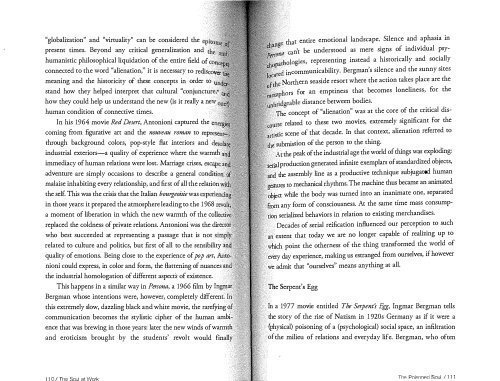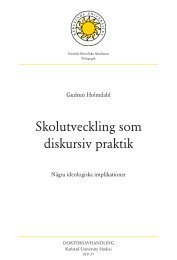Franco ''Bifo'' Berardi - The Soul at Work From Alienation to Autonomy
Franco ''Bifo'' Berardi - The Soul at Work From Alienation to Autonomy
Franco ''Bifo'' Berardi - The Soul at Work From Alienation to Autonomy
- No tags were found...
Create successful ePaper yourself
Turn your PDF publications into a flip-book with our unique Google optimized e-Paper software.
"globaliz<strong>at</strong>ion" and "virtuality" can be considered thepresent times. Beyond any critical generaliz<strong>at</strong>ion andhumanistic philosophical liquid<strong>at</strong>ion of the entire field ofconnected <strong>to</strong> the word "alien<strong>at</strong>ion,)) it is necessary <strong>to</strong> re(lis(;ov."meaning and the his<strong>to</strong>ricity of these concepts in order <strong>to</strong>stand how they helped interpret th<strong>at</strong> cultural "conjuncture,how they could help us understand the new (is ir really a newhuman condition of connective times.In his 1964 movie Red Desert, An<strong>to</strong>nioni captured thecoming from figur<strong>at</strong>ive art and the nouveau roman <strong>to</strong> rep'res,elit_rhrough background colors, pop-style R<strong>at</strong> interiors andindustrial exteriors-a quality of experience where the warmthimmediacy of human rel<strong>at</strong>ions were lost. Marriage crises, escap(, anadventure are simply occasions <strong>to</strong> describe a general cOlndiitie'n tmalaise inhabiting every rel<strong>at</strong>ionship, and first of all the rel,.tie'n vlitthe self. This was the crisis th<strong>at</strong> the Italian bourgeoisie was ex],eriien>:iniin those years: it prepared the <strong>at</strong>mosphere leading <strong>to</strong> the 1968a moment of liber<strong>at</strong>ion in which the new warmth of the COllectlvereplaced the coldness of priv<strong>at</strong>e rel<strong>at</strong>ions. An<strong>to</strong>nioni was the dir,ect()rwho best succeeded <strong>at</strong> representing a passage th<strong>at</strong> is notrel<strong>at</strong>ed <strong>to</strong> culture and politics, but first of all <strong>to</strong> the sensibilityquality of emotions. Being close <strong>to</strong> the experience of pop art,nioni could express, in color and form, the R<strong>at</strong>tening of nuancesthe industrial homolog<strong>at</strong>ion of different aspects of existence.This happens in a similar way in Persona, a 1966 film by Tn"m.,Bergman whose intentions were, however, completely different. Inthis extremely slow, dazzling black and white movie, the rarefYing ofcommunic<strong>at</strong>ion becomes the stylistic cipher of the human ambienceth<strong>at</strong> was brewing in those ye<strong>at</strong>s: l<strong>at</strong>er the new winds of warmthand eroticism brought by the students' revolt would finallyth<strong>at</strong> entire emotional landscape. Silence and aphasia incan't be unders<strong>to</strong>od as mere signs of individual psyrepresentinginstead a his<strong>to</strong>rically and sociallyincommunicability. Bergman's silence and the sunny sitesNorthern seaside resort where the action takes place are thefor an emptiness th<strong>at</strong> becomes loneliness, for thembridgea.ble distance between bodies.<strong>The</strong> concept of "alien<strong>at</strong>ion" waS <strong>at</strong> the core of the critical disrel<strong>at</strong>ed<strong>to</strong> these two movies, extremely significant for thescene of th<strong>at</strong> decade. In th<strong>at</strong> context, alien<strong>at</strong>ion referred <strong>to</strong>submission of the person <strong>to</strong> the thing.At the peak of the industrial age the world of things was exploding:serial production gener<strong>at</strong>ed infinite exemplars of standardized objects,and the assembly line as a productive technique subjug<strong>at</strong>ed humangestures <strong>to</strong> mechanical rhythms. <strong>The</strong> machine thus became an anim<strong>at</strong>edobject while the body was turned in<strong>to</strong> an inanim<strong>at</strong>e one, separ<strong>at</strong>edfrom any form of consciousness. At the same time mass consumptionserialized behaviors in rel<strong>at</strong>ion <strong>to</strong> existing merchandises.Decades of serial reific<strong>at</strong>ion inRuenced our perception <strong>to</strong> suchan extent th<strong>at</strong> <strong>to</strong>day we are no longer capable of realizing up <strong>to</strong>which point the otherness of the thing transformed the world ofevety day experience, making us estranged from ourselves, if howeverwe admit th<strong>at</strong> "ourselves" means anything <strong>at</strong> all.<strong>The</strong> Serpent's EggIn a 1977 movie entitled <strong>The</strong> Serpent's Egg, Ingmar Bergman tellsthe s<strong>to</strong>ry of the rise of Nazism in 1920s Germany as if it were a(physical) poisoning of a (psychological) social space, an infiltr<strong>at</strong>ionof the milieu of rel<strong>at</strong>ions and everyday life. Bergman, who oftenTill"! Pnisonfrl <strong>Soul</strong> I 111






